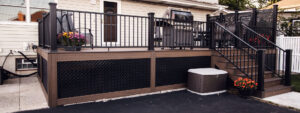To build something strong and reliable, it helps to understand the parts that make it work. The same goes for decks! Knowing the structure and how each piece fits together is key to creating a safe, sturdy, and durable deck.
At Royal Deck, decks are our specialty. We’ve created this easy-to-follow deck construction guide to help DIY builders understand the basic anatomy of a deck and how the components work together. Let’s break it down step by step!

Deck Foundations: Footings and Posts
Think of your deck as a sturdy tree. Just as a tree’s roots anchor it firmly in the ground and keep it upright, your deck needs a solid foundation to stay safe and stable. The footings and posts act as the “roots” of your deck, ensuring it can handle the weight above while staying secure through changing seasons.
The Role of Footings
Footings are the backbone of your deck’s foundation, distributing its weight evenly across the ground to prevent sinking or shifting. Typically made of concrete, footings are poured into holes below the frost line to protect them from freeze-thaw cycles, which can cause the ground to expand and contract.
This frost line placement in colder climates is especially important to maintain stability year-round. Without properly installed footings, your deck risks uneven settling, compromising its structure and safety.
The Importance of Support Posts
Support posts rise from the footings to hold up the deck frame, much like the trunk of a tree. These vertical beams are secured to the concrete footings using metal brackets, keeping them elevated above the ground to avoid moisture damage.
For taller decks or those built on sloped terrain, posts may need additional bracing to prevent buckling under heavy loads. Correct placement and alignment of these posts are critical, as they transfer the weight of the deck and anything on it—like furniture or people—down to the footings.
Deck Frames: Joists, Beams, and Rim Joists Explained
The frame of your deck is like the skeleton of your body—it holds everything together and provides the strength needed to support weight and movement. Joists, beams, and rim joists are the key components of the deck structure, each playing an important role in keeping your deck safe and stable.
What Are Joists?
Joists are the horizontal boards that sit across the beams to support your decking material. They act like the “ribs” of the frame, creating the foundation for the surface of your deck. Proper joist spacing is essential to avoid sagging or a bouncy feel underfoot.
For most decks, joists are spaced 16 inches apart, but this can vary depending on the type of decking you choose. For example, heavier materials or diagonal decking patterns may require joists spaced closer together, typically 12 inches apart.
The Job of Beams
Beams are the backbone of your deck frame. These strong, horizontal boards are positioned under the joists and are responsible for carrying the entire load of the deck. Beams distribute the weight evenly to the support posts to improve your deck’s strength and stability.
When choosing beams, their size and type depend on your deck’s overall size and how much weight it needs to support. Larger decks or those designed to hold heavy furniture or hot tubs may require multiple beams or larger ones to handle the load.
What Are Rim Joists?
Rim joists are the outermost boards of the deck frame, running along the edges to tie the structure together. They act like a belt, providing extra stability and securely holding the frame.
Rim joists also play a big role in the deck’s appearance, creating a clean, finished look around the edges. They’re often reinforced with blocking or additional screws to prevent twisting and ensure the deck structure remains square and sturdy.
Why Proper Spacing and Sizing Matter
Getting the spacing and sizing of joists and beams right ensures your deck can handle the weight of people, furniture, and anything else you plan to use it for. Incorrect spacing could lead to structural issues or even safety hazards.

Decking Materials: Wood Vs. Composite
Deck flooring is the surface you walk on and the part of the deck that you’ll see and use the most. Choosing the right material is essential for creating a deck that looks great, feels comfortable, and lasts for years. Let’s take a look at the two most common deck flooring materials:
Wood: The Traditional Option
For years, wood has been a popular choice for deck flooring. Materials like cedar, redwood, and pressure-treated pine offer a natural, timeless look. However, wood requires regular maintenance, including staining, sealing, and repairs, to protect it from weather damage, rot, and insects. Over time, wood can splinter, warp, and fade, which means more upkeep for homeowners.
Composite Decking: The Modern Solution
Composite decking has revolutionized the deck-building industry and is now the top choice for many homeowners. Made from a blend of recycled wood fibers and high-performance polymers, composite combines the best qualities of wood and synthetic materials. Here’s why composite decking stands out:
- Low Maintenance: Unlike wood, composite decking doesn’t require staining, sealing, or frequent repairs. A quick clean with soap and water is all it takes to keep it looking fresh.
- Durability: Composite decking resists cracking, splintering, and warping. It’s also moisture-resistant, so it won’t rot or grow mold like traditional wood can.
- Weather-resistant: Whether it’s rain, snow, or harsh sun, composite decking withstands the elements without fading or deteriorating.
- Eco-Friendly: Many composite materials are recycled, making it a sustainable choice for environmentally conscious homeowners.
- Aesthetic Variety: Composite comes in a wide range of colors and textures, often mimicking the look of natural wood. You can choose a finish that perfectly matches your style and complements your home.

Railings, Stairs, and Finishes: The Final Touches
Once your main deck structure is complete, it’s time to focus on the final touches that bring everything together. Railings, stairs, and finishes are not just functional—they add style and personality to your deck. Let’s break these elements down so you can make informed decisions for your outdoor space.
Deck Railings
Railings are necessary for your deck, especially if it’s elevated. They keep your family and guests safe by providing a barrier that prevents falls. But railings also contribute to the overall design of your deck, giving it a polished and complete look.
- Safety First: Railings must meet building codes specifying height and spacing requirements. For example, railings should be high enough to keep people safe and have balusters close enough together to prevent small children from slipping through.
- Design Options: You can choose railings made of wood, metal, vinyl, composite, or PVC materials. Each option offers a different look and level of maintenance.
Deck Stairs
Deck stairs provide a safe and convenient way to move between your deck and yard. Proper construction is key to ensuring they’re sturdy and easy to use.
- Building Code Compliance: Stairs must meet specific requirements like tread depth and riser height. Handrails may also be required for added security.
- Durability and Design: Just like the deck itself, stairs should be built with durable materials that resist weather and wear. Composite materials are an excellent choice for stairs, as they are slip-resistant and easy to maintain.
Build the Deck of Your Dreams with Royal Deck
Understanding the anatomy of a deck is the first step in creating a safe, durable, and beautiful outdoor space. From solid foundations to stylish finishes, every component plays a role in the deck’s overall strength and appearance. Whether you’re a DIY enthusiast or looking for expert craftsmanship, having the right knowledge is key to a successful deck project.
Atlanta’s Royal Deck specializes in building new decks, porches, and deck resurfacing. Our team is dedicated to creating outdoor spaces that combine functionality and style and are tailored to your specific needs. Ready to start your dream deck project? Contact Royal Deck today, and let us bring your vision to life!







